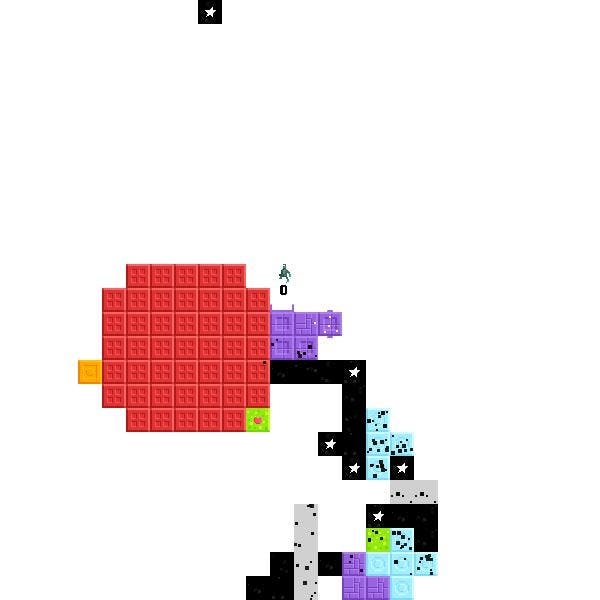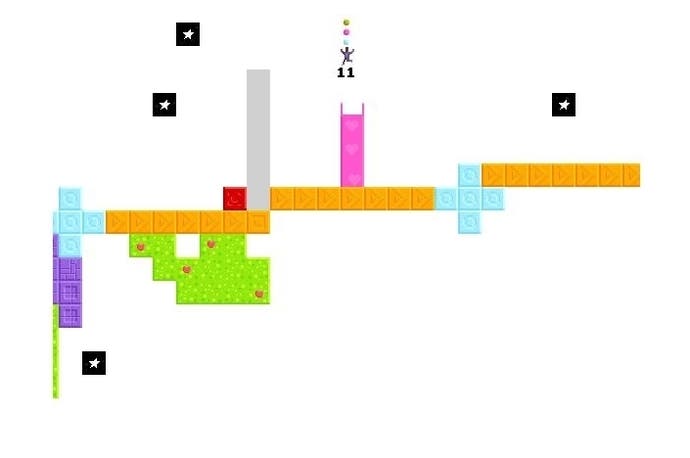Starseed Pilgrim review
Grows on you.
One of gaming's oddities is that enormous numbers of people enjoy puzzle games, yet there's far less interest in games that are puzzles. Starseed Pilgrim is an enigmatic game, one that could be easily spoiled by a few explanatory lines or a diagram - part platformer and part memory challenge, it hinges on the player's ingenuity and love of discovery. It's one of those that gives back what you put in.
The game takes place on blocks floating in a small rectangle of white space, and you play the pilgrim: a stick figure who can jump, tunnel and plant starseeds. A simple introductory screen explains all of this, though you'll need to check the 'readme' file for one important instruction that should really be in the game - dig pink blocks to get more starseeds.
After this opening, Starseed Pilgrim has had enough of petty explanations, and any more instructions are of the most oblique kind. Certain points in the world are surrounded by spare, melancholy lines, fragments on a common theme framing your ongoing activities. Starseed Pilgrim has a kind of home area you'll be seeing much of, an area you return to after both defeat and triumph, and its first offering is a door to another place.

Through here is where you can start planting starseeds and experimenting. The pilgrim's controls are child's play: arrow keys for movement, up to jump, space to plant a seed and double-tap to tunnel sideways or down. You begin these areas atop a large pile of grey bricks which are gradually being swallowed at the lower end by the influence of a star; the brightly-coloured starseeds let you grow out and away from the corrupting blackness, though you'll never quite escape it.
There are eight colours of starseed and no limit to how many you can carry - the catch is, you can't choose which one to plant next. The three seeds you have immediately incoming float above the pilgrim's head, which allows for a bit of forward planning, but at first you just have to learn how they all work. Each colour of seed grows in a particular way and the blocks it produces have their own kinks; pink ones, for example, grow straight upwards at a slow rate, and each complete block can be dug for an extra seed.
I don't want to go through delineating what each seed does, because Starseed Pilgrim depends on each player doing that for themselves, but their individual forms are tightly bound together in a way that isn't immediately obvious. Your first breakthrough will be simply knowing what colour grows in what way; the second is how they can be made to fit together in approximate patterns; the third is why.
What's next is a bit of a mini-spoiler, so if you like the sound of Starseed Pilgrim give this paragraph a miss and get thee to the website. The puzzle of how the seed types interlock is only really the opening as, after you've worked out the basics, other avatars come along that bring their own small changes of pace to growing - starseeds might sprout faster, for example. This means that, just as you're mastering what the types do and how to build, the game makes a shift. This particular change isn't merely a mechanical one, either. It also brings the beautiful and delicately crafted audio front-and-centre.
Starseed Pilgrim is a discovery, a gem that does things you've never quite seen before
Each colour of block has an instrument associated with it, and as they grow and complete, an arpeggio plays. Most starseeds sprout multiple blocks, so plant two or three at the same time and there's a cascade of perfectly-harmonised notes as they grow. This in itself makes growing a pleasure. But it's also a mechanic in its own right. Starseed Pilgrim restricts your view somewhat, and it's not practical to go back and keep checking the corruption's spread. Instead, you can hear it spreading, a much lower frequency of sound but ever-present in the background, and much more notable in your proximity.
So you're growing a series of platforms, and growing further structures out of them. Towards what? This is frustrating I know, but: best to work it out yourself. It's pretty obvious after a few games anyway, and what's even more interesting is what happens at the end of each growing session - the moment when you run out of seeds and the spreading corruption has you trapped. Delay as you will - and it's possible to plant for ages without being caught - eventually the pilgrim is touched by the blackness.
At this point, Starseed Pilgrim's bright world becomes a spare and muffled monotone, and you play on in a different way. What happens here is a quite brilliant piece of design, and gives a meaning to the player's role and creativity within this world. It feels like a simple bait-and-switch at first, but underneath is a deep and finely-honed system that you quickly attune to. It delivers on a concept both narratively and mechanically, and very few games do that.

It's frustrating have to dance around these specifics, but to do otherwise would be the height of arrogance. Starseed Pilgrim has its effect because it's a discovery, a gem that does things you've never quite seen before. It's a game that doesn't explain itself at all and is happy to let you run up cul-de-sacs trying to figure it out - but when the system begins to make sense, it's an absolute delight.
Starseed Pilgrim needs time. Chewing away on little parts of its puzzle and thinking about its mechanics are the stuff of daydreams. There's a true beauty in how such simple principles combine into layers of complexity and, beyond even this, sync aesthetically. The learning curve is more like a wall, but scale it and there's an expansive surprise.
The elements of this world do get into your head a little, and each player will have their own idea of how to tie them together - what it all means, whether it means anything at all. Its purity of concept could be taken as wilful obscurity, original to a fault, but Starseed Pilgrim also has a system worth mastering, and a mystery worth pursuing.


